Contrasting Influences of Seasonal and Intra-Seasonal Hydroclimatic Variabilities on the Irrigated Rice Paddies of Northern Peninsular Malaysia for Weather Index Insurance Design
Abstract
:1. Introduction
2. Materials and Methods
2.1. Study Area
2.2. Data Collection
2.3. Derivation of Average and Extreme Hydroclimatic Indices
2.4. Correlation Analysis and Linear Regression
3. Results
3.1. Seasonal and Intra-Seasonal Variability in the Hydroclimatic Indices
3.2. Hydroclimatic Controls on Yield in the Dry, Mainly Irrigated Season 1
3.3. Hydroclimatic Controls on Yield in the Wetter Season 2
3.4. Stepwise Regression and Forecast Skill
4. Discussion
4.1. Hydroclimatic Controls in Relation to Crop Phenological Stages
4.2. Contrasting Hydroclimatic Controls on Yield between Dry and Wet Seasons
5. Conclusions
Author Contributions
Funding
Institutional Review Board Statement
Informed Consent Statement
Data Availability Statement
Acknowledgments
Conflicts of Interest
References
- Prasad, R.; Shivay, Y.S.; Kumar, D. Current status, challenges, and opportunities in rice production. In Rice Production Worldwide; Springer: Berlin/Heidelberg, Germany, 2017; pp. 1–32. [Google Scholar]
- Siwar, C.; Idris, N.D.M.; Yasar, M.; Morshed, G. Issues and challenges facing rice production and food security in the granary areas in the East Coast Economic Region (ECER), Malaysia. Res. J. Appl. Sci. Eng. Technol. 2014, 7, 711–722. [Google Scholar] [CrossRef]
- Bishwajit, G.; Sarker, S.; Kpoghomou, M.-A.; Gao, H.; Jun, L.; Yin, D.; Ghosh, S. Self-sufficiency in rice and food security: A South Asian perspective. Agric. Food Secur. 2013, 2, 10. [Google Scholar] [CrossRef] [Green Version]
- Omar, S.C.; Shaharudin, A.; Tumin, S.A. The Status of the Paddy and Rice Industry in Malaysia; Khazanah Research Institute: Kuala Lumpur, Malaysia, 2019. [Google Scholar]
- Faostat. FAO Statistical Pocketbook 2015 World Food and Agriculture 2015; FAO: Rome, Italy, 2015. [Google Scholar]
- Vaghefi, N.; Shamsudin, M.N.; Radam, A.; Rahim, K.A. Impact of climate change on food security in Malaysia: Economic and policy adjustments for rice industry. J. Integr. Environ. Sci. 2016, 13, 19–35. [Google Scholar] [CrossRef]
- Alam, M.; Siwar, C.; Islam, R.; Toriman, M.E.; Basri, T. Climate change and vulnerability of paddy cultivation in north-west Selangor, Malaysia: A survey of farmers’ assessment/Md. Mahmudul Alam…[et al.]. Acad. Ser. Univ. Teknol. MARA Kedah 2011, 6, 45–56. [Google Scholar]
- Pio Lopez, G. ‘Economic reforms for paddy sub-sector’. Star Online. 2007, 25. Available online: https://www.thestar.com.my/business/business-news/2007/06/25/economic-reforms-for-paddy-subsector (accessed on 13 January 2021).
- Asia Pacific Adaptation Network. Promoting Risk Financing in the Asia Pacific Region: Lessons from Agriculture Insurance in Malaysia, Philippines and Vietnam; Institute for Global Environmental Strategies (IGES): Kanagawa, Japan, 2013. [Google Scholar]
- Mahul, O.; Stutley, C.J. Government Support to Agricultural Insurance: Challenges and Options for Developing Countries; World Bank: Washington, DC, USA, 2010. [Google Scholar]
- Porth, L.; Lin, J.; Boyd, M.; Pai, J.; Zhang, Q.; Wang, K. Factors affecting farmers’ willingness to purchase weather index insurance in the Hainan Province of China. Agric. Financ. Rev. 2015, 75, 103–113. [Google Scholar]
- Choudhury, A.; Jones, J.; Okine, A.; Choudhury, R. Drought-triggered index insurance using cluster analysis of rainfall affected by climate change. J. Insur. Issues 2016, 39, 169–186. [Google Scholar]
- Khalil, A.F.; Kwon, H.; Lall, U.; Miranda, M.J.; Skees, J. El Niño–Southern Oscillation–based index insurance for floods: Statistical risk analyses and application to Peru. Water Resour. Res. 2007, 43. [Google Scholar] [CrossRef]
- Barnett, B.J.; Mahul, O. Weather index insurance for agriculture and rural areas in lower-income countries. American J. Agric. Econ. 2007, 89, 1241–1247. [Google Scholar] [CrossRef]
- Barrett, C.B.; Barnett, B.J.; Carter, M.R.; Chantarat, S.; Hansen, J.W.; Mude, A.G.; Osgood, D.; Skees, J.R.; Turvey, C.G.; Ward, M.N. Poverty Traps and Climate Risk: Limitations and Opportunities of Index-Based Risk Financing. Iri Tech. Rep. No. 07-02. 2007. Available online: https://iri.columbia.edu/ (accessed on 13 January 2021).
- Cao, M.; Li, A.; Wei, J.Z. Precipitation modeling and contract valuation: A frontier in weather derivatives. J. Altern. Invest. 2004, 7, 93–99. [Google Scholar] [CrossRef]
- Chen, W.; Hohl, R.; Tiong, L.K. Rainfall index insurance for corn farmers in Shandong based on high-resolution weather and yield data. Agric. Financ. Rev. 2017, 77, 337–354. [Google Scholar] [CrossRef]
- Heimfarth, L.E.; Musshoff, O. Weather index-based insurances for farmers in the North China Plain: An analysis of risk reduction potential and basis risk. Agric. Financ. Rev. 2011, 71, 218–239. [Google Scholar] [CrossRef]
- Breustedt, G.; Bokusheva, R.; Heidelbach, O. Evaluating the potential of index insurance schemes to reduce crop yield risk in an arid region. J. Agric. Econ. 2008, 59, 312–328. [Google Scholar] [CrossRef]
- Pelka, N.; Musshoff, O. Hedging effectiveness of weather derivatives in arable farming–is there a need for mixed indices? Agric. Financ. Rev. 2013, 73, 358–372. [Google Scholar] [CrossRef]
- Vedenov, D.V.; Barnett, B.J. Efficiency of weather derivatives as primary crop insurance instruments. J. Agric. Resour. Econ. 2004, 29, 387–403. [Google Scholar]
- Brown, C.; Carriquiry, M. Managing hydroclimatological risk to water supply with option contracts and reservoir index insurance. Water Resour. Res. 2007, 43. [Google Scholar] [CrossRef]
- Leiva, A.J.; Skees, J.R. Using Irrigation Insurance to Improve Water Usage of the Rio Mayo Irrigation System in Northwestern Mexico. World Dev. 2008, 36, 2663–2678. [Google Scholar] [CrossRef]
- Siebert, A. Analysis of index insurance potential for adaptation to hydroclimatic risks in the west African Sahel. WeatherClim. Soc. 2016, 8, 265–283. [Google Scholar] [CrossRef]
- Kost, A.; Läderach, P.; Fisher, M.; Cook, S.; Gómez, L. Improving index-based drought insurance in varying topography: Evaluating basis risk based on perceptions of Nicaraguan hillside farmers. PLoS ONE 2012, 7, e51412. [Google Scholar] [CrossRef] [PubMed] [Green Version]
- Stojanovski, P.; Dong, W.; Wang, M.; Ye, T.; Li, S.; Mortgat, C.P. Agricultural risk modeling challenges in China: Probabilistic modeling of rice losses in Hunan Province. Int. J. Disaster Risk Sci. 2015, 6, 335–346. [Google Scholar] [CrossRef] [Green Version]
- Carter, M.; De Janvry, A.; Sadoulet, E.; Sarris, A. Index Insurance for Developing Country Agriculture: A reassessment. Annu. Rev. Resour. Econ. 2017, 9, 421–438. [Google Scholar] [CrossRef]
- Leblois, A.; Quirion, P. Agricultural insurances based on meteorological indices: Realisations, methods and research challenges. Meteorol. Appl. 2013, 20, 1–9. [Google Scholar] [CrossRef] [Green Version]
- Kang, Y.; Khan, S.; Ma, X. Climate change impacts on crop yield, crop water productivity and food security–A review. Prog. Nat. Sci. 2009, 19, 1665–1674. [Google Scholar] [CrossRef]
- Lal, R.; Uphoff, N.; Stewart, B.A.; Hansen, D.O. Climate Change and Global Food Security; CRC Press: Boca Raton, FL, USA, 2005. [Google Scholar]
- Magadza, C.H.D. Climate change impacts and human settlements in Africa: Prospects for adaptation. Environ. Monit. Assess. 2000, 61, 193–205. [Google Scholar] [CrossRef]
- Austin, O.C.; Baharuddin, A.H. Risk in Malaysian agriculture: The need for a strategic approach and a policy refocus. Kajian Malaysia J. Malays. Stud. 2012, 30, 21–50. [Google Scholar]
- Prabhakar, S.; Suryahadi, S.; Setyanto, P. Mitigation co-benefits of adaptation actions in agriculture: An opportunity for promoting climate smart agriculture in Indonesia. Asian J. Environ. Disaster Manag. 2013, 5, 261–276. [Google Scholar] [CrossRef]
- Academy of Science Malaysia. El Niño: A Review of Scientific Understanding and the Impact of 1997/98 Event in Malaysia; Academy of Science Malaysia: Kuala Lumpur, Malaysia, 2018. [Google Scholar]
- Al-Amin, A.Q.; Alam, G.M. Impact of El-Niño on agro-economics in Malaysia and the surrounding regions: An analysis of the events from 1997–1998. Asian J. Earth Sci. 2016, 9, 1–8. [Google Scholar]
- Hanafiah, M.M.; Ghazali, N.F.; Harun, S.N.; Abdulaali, H.; Abdul-Hasan, M.J.; Kamarudin, M.K.A. Assessing water scarcity in Malaysia: A case study of rice production. Desalin. Water Treat 2019, 149, 274–287. [Google Scholar] [CrossRef] [Green Version]
- Maidin, K.H.; Mohamad, C.K.B.I.; Othman, S.K.B. Impacts of natural disasters on the paddy production and its implications to the economy. Fftc Agric. Policy Platf. 2015. Available online: https://ap.fftc.org.tw/article/970 (accessed on 13 January 2021).
- Firdaus, R.B.R.; Leong Tan, M.; Rahmat, S.R.; Senevi Gunaratne, M. Paddy, rice and food security in Malaysia: A review of climate change impacts. Cogent Soc. Sci. 2020, 6, 1818373. [Google Scholar] [CrossRef]
- Department of Statistics Malaysia. Press Release: Demographic Statistics First Quarter 2020, Malaysia 2020; Department of Statistics: Putrajaya, Malaysia, 2020.
- Lansigan, F.P. Implementation Issues in Weather Index-based Insurance for Agricultural Production: A Philippine Case Study; IGES: Hayama, Japan; SEARCA: Los Baños, Laguna, Philippines, 2015; Available online: https://www.searca.org/pubs/briefs-notes?pid=288 (accessed on 13 January 2021).
- Suhaila, J.; Deni, S.M.; Zin, W.Z.W.; Jemain, A.A. Trends in peninsular Malaysia rainfall data during the southwest monsoon and northeast monsoon seasons: 1975–2004. Sains Malays. 2010, 39, 533–542. [Google Scholar]
- Wong, C.L.; Liew, J.; Yusop, Z.; Ismail, T.; Venneker, R.; Uhlenbrook, S. Rainfall characteristics and regionalization in Peninsular Malaysia based on a high resolution gridded data set. Water 2016, 8, 500. [Google Scholar] [CrossRef] [Green Version]
- Julien, P.Y.; Ghani, A.A.; Zakaria, N.A.; Abdullah, R.; Chang, C.K. Case study: Flood mitigation of the Muda River, Malaysia. J. Hydraul. Eng. 2010, 136, 251–261. [Google Scholar] [CrossRef] [Green Version]
- Aisyah Baharudin, S.; Arshad, F.M.; Baharudin, S.A. Water management in the paddy area in MADA. Econ. Technol. Manag. Rev. 2015, 10, 21–29. Available online: http://etmr.mardi.gov.my/Content/ETMRVol.10a(2015)/Vol10a(3).pdf (accessed on 13 January 2021).
- Peña-Angulo, D.; Reig-Gracia, F.; Domínguez-Castro, F.; Revuelto, J.; Aguilar, E.; van der Schrier, G.; Vicente-Serrano, S.M. ECTACI: European Climatology and Trend Atlas of Climate Indices (1979–2017). J. Geophys. Res. Atmos. 2020, 125, e2020JD032798. [Google Scholar] [CrossRef]
- Bring, J. How to standardize regression coefficients. Am. Stat. 1994, 48, 209–213. [Google Scholar]
- Cavanaugh, J.E. Unifying the derivations for the Akaike and corrected Akaike information criteria. Stat. Probab. Lett. 1997, 33, 201–208. [Google Scholar] [CrossRef]
- Ghadirnezhad, R.; Fallah, A. Temperature effect on yield and yield components of different rice cultivars in flowering stage. Int. J. Agron. 2014, 846707. [Google Scholar] [CrossRef]
- Krishnan, P.; Ramakrishnan, B.; Reddy, K.R.; Reddy, V.R. High-temperature effects on rice growth, yield, and grain quality. Adv. Agron. 2011, 111, 87–206. [Google Scholar]
- Guo, J.; Jin, J.; Tang, Y.; Wu, X. Design of temperature insurance index and risk zonation for single-season rice in response to high-temperature and low-temperature damage: A case study of Jiangsu province, China. Int. J. Environ. Res. Public Health 2019, 16, 1187. [Google Scholar] [CrossRef] [Green Version]
- Abbas, S.; Mayo, Z.A. Impact of temperature and rainfall on rice production in Punjab, Pakistan. Environ. Dev. Sustain. 2021, 23, 1706–1728. [Google Scholar] [CrossRef]
- Joseph, K.; Menon, P.K.G.; Koruth, A. Influence of weather parameters on wetland rice yields in Kerala. Oryza 1988, 25, 365–368. [Google Scholar]
- Asada, H.; Matsumoto, J. Effects of rainfall variation on rice production in the Ganges-Brahmaputra Basin. Clim. Res. 2009, 38, 249–260. [Google Scholar] [CrossRef] [Green Version]
- Sridevi, V.; Chellamuthu, V. Impact of weather on rice–A review. Int. J. Appl. Res. 2015, 1, 825–831. [Google Scholar]
- Lawson, D.A.; Rands, S.A. The effects of rainfall on plant–pollinator interactions. Arthropod-Plant Interact. 2019, 13, 561–569. [Google Scholar] [CrossRef] [Green Version]
- Mo’allim, A.A.; Kamal, M.R.; Muhammed, H.H.; Mohd Soom, M.A.; Zawawi, M.; Wayayok, A.; Bt, H. Assessment of nutrient leaching in flooded paddy rice field experiment using Hydrus-1D. Water 2018, 10, 785. [Google Scholar] [CrossRef] [Green Version]
- Sawada, H.; Kusmayadi, A.; Gaib Subroto, S.W.; Suwardiwijaya, E. Comparative analysis of population characteristics of the brown planthopper, Nilaparvata lugens Stål, between wet and dry rice cropping seasons in West Java, Indonesia. Popul. Ecol. 1993, 35, 113–137. [Google Scholar] [CrossRef]
- Madhuri, G.; Dash, P.C.; Rout, K.K. Effect of weather parameters on population dynamics of paddy pests. Int. J. Curr. Microbiol. Appl. Sci. 2017, 6, 2049–2053. [Google Scholar] [CrossRef]
- Rath, P.C.; Jena, M.; Behera, K.S.; Sasmal, S. Pest outbreaks and resurgence in rice ecosystem in Odisha—A retrospect. In Proceedings of the 7th National Seminar on Emerging Climate Change Issues and Sustainable Management Strategies, Bhubaneswar, India, 8–19 February 2014; pp. 20–21. [Google Scholar]
- Gubbaiah, D.D.; Revana, H.P. The rice white-backed plant hopper (WBPH) in Karnataka. Int. Rice Res. Newsl. 1987, 12, 34. [Google Scholar]
- Prabnakorn, S.; Maskey, S.; Suryadi, F.X.; de Fraiture, C. Rice yield in response to climate trends and drought index in the Mun River Basin, Thailand. Sci. Total Environ. 2018, 621, 108–119. [Google Scholar] [CrossRef]
- Kattelus, M.; Salmivaara, A.; Mellin, I.; Varis, O.; Kummu, M. An evaluation of the Standardized Precipitation Index for assessing inter-annual rice yield variability in the Ganges–Brahmaputra–Meghna region. Int. J. Climatol. 2016, 36, 2210–2222. [Google Scholar] [CrossRef]
- Kaffashi, S. Assessing the impacts of climate change on paddy production in Malaysia. Res. J. Environ. Sci. 2014, 8, 331–341. [Google Scholar]
- Firdaus, R.R.; Latiff, I.A.; Borkotoky, P. The impact of climate change towards Malaysian paddy farmers. J. Dev. Agric. Econ. 2012, 5, 57–66. [Google Scholar] [CrossRef] [Green Version]
- Wen, Y.W.J.; Ponnusamy, R.R.; Kang, H.M. Application of weather index-based insurance for paddy yield: The case of Malaysia. Int. J. Adv. Appl. Sci. 2019, 6, 51–59. [Google Scholar]
- Adegoke, J.; Pramod, A.; Rüegg, M.; Hansen, J.; Cuellar, D.; Diro, R.; Shaw, R.; Hellin, J.; Greatrex, H.; Zougmoré, R. Review of Index-Based Insurance for Climate-Smart Agriculture: Improving Climate Risk Transfer and Management for Climate-Smart Agriculture—A Review of Existing Examples of Successful Index-Based Insurance for Scaling up; Food Agriculture Organization (FAO): Rome, Italy, 2017. [Google Scholar]
- Kumar, D.S.; Barah, B.C.; Ranganathan, C.R.; Venkatram, R.; Gurunathan, S.; Thirumoorthy, S. An analysis of farmers’ perception and awareness towards crop insurance as a tool for risk management in Tamil Nadu. Agric. Econ. Res. Rev. 2011, 24, 37–46. [Google Scholar]
- Rathod, M.K.; Chavan, S.U.; Rathod, T. Farmers Awareness and Perception towards Crop Insurance as a Risk Management Tool. J. Glob. Commun. 2016, 9, 118–122. [Google Scholar] [CrossRef]
- Dalhaus, T.; Finger, R. Can gridded precipitation data and phenological observations reduce basis risk of weather index–based insurance? WeatherClim. Soc. 2016, 8, 409–419. [Google Scholar] [CrossRef]

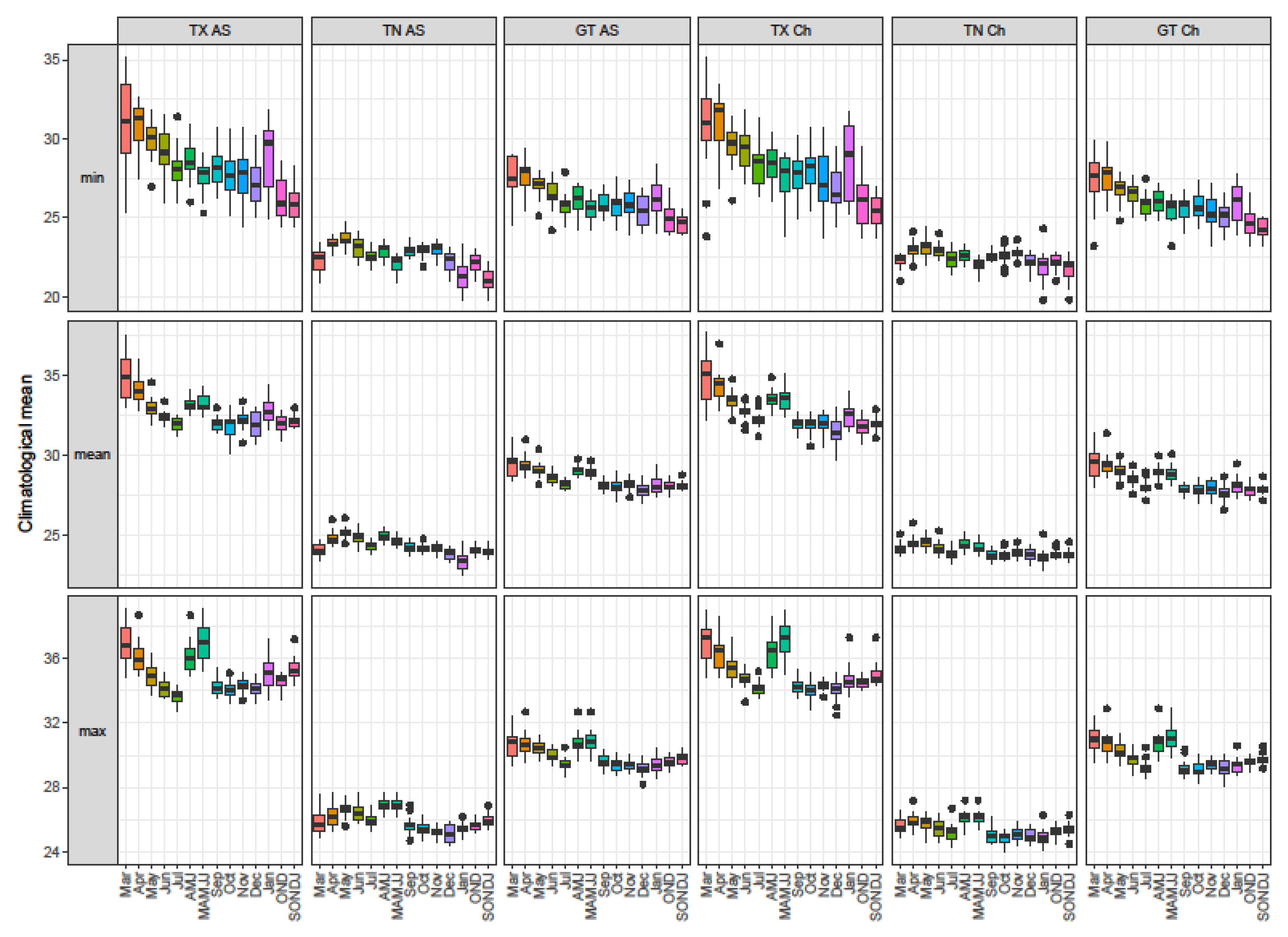

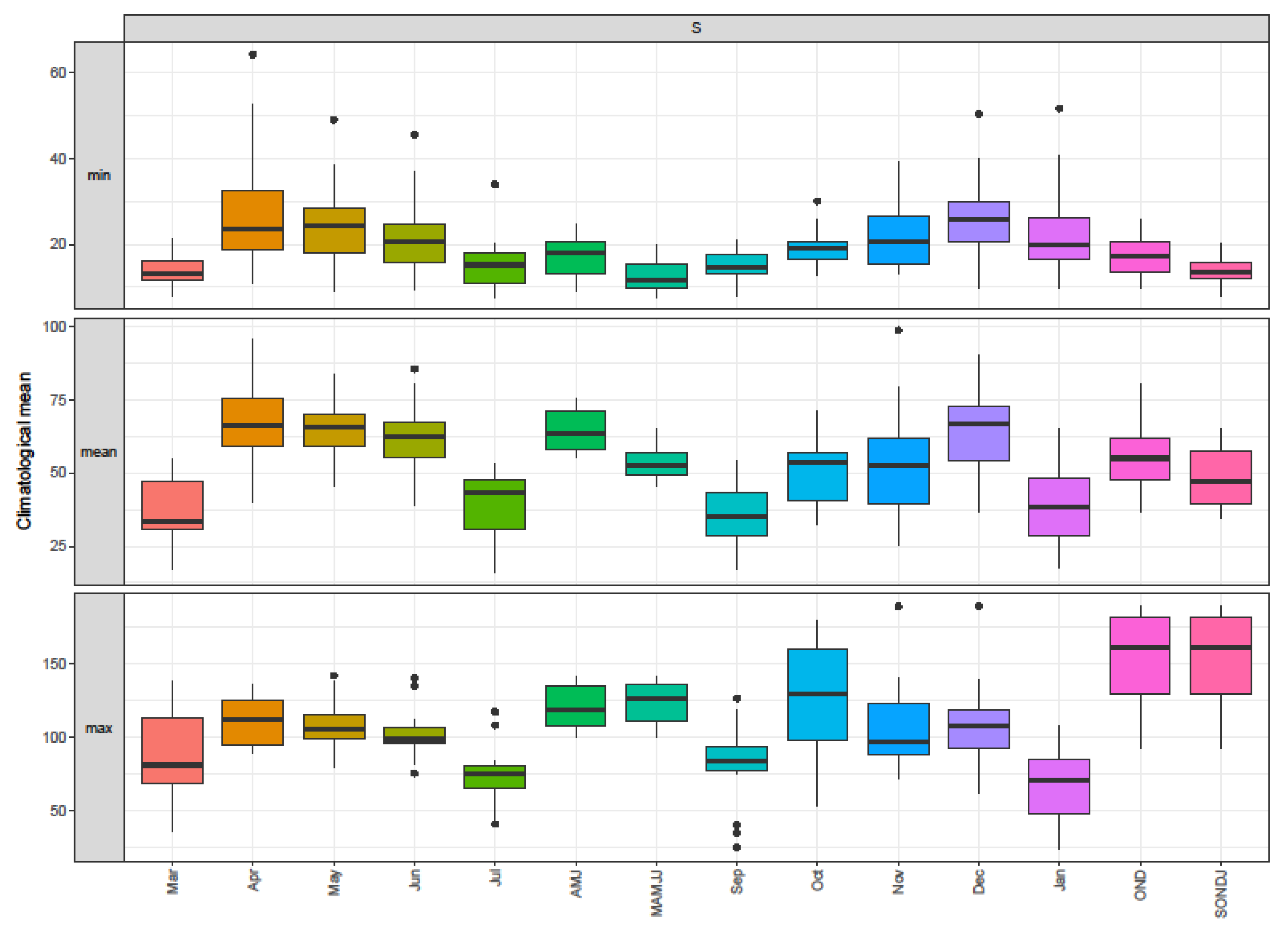
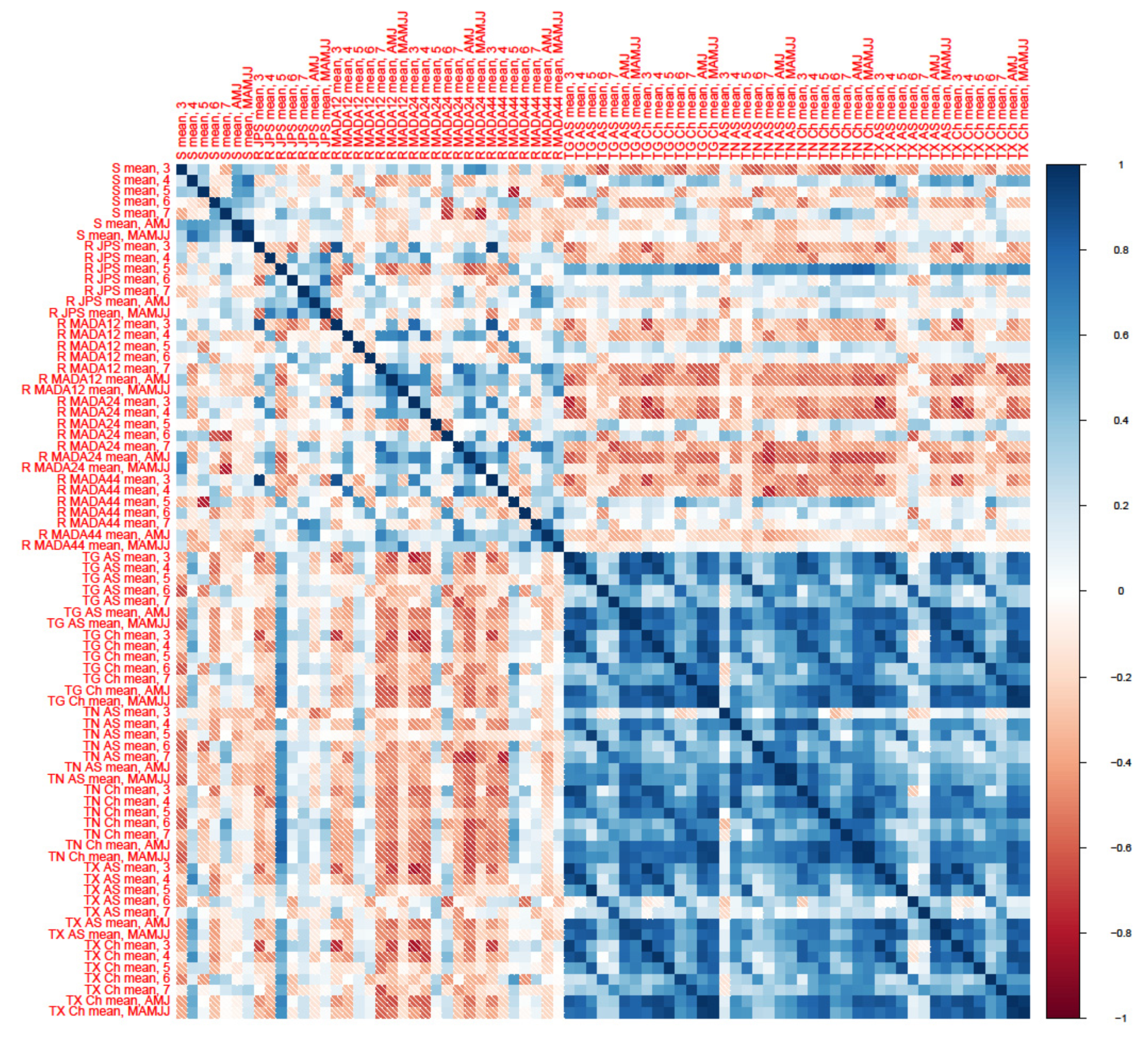
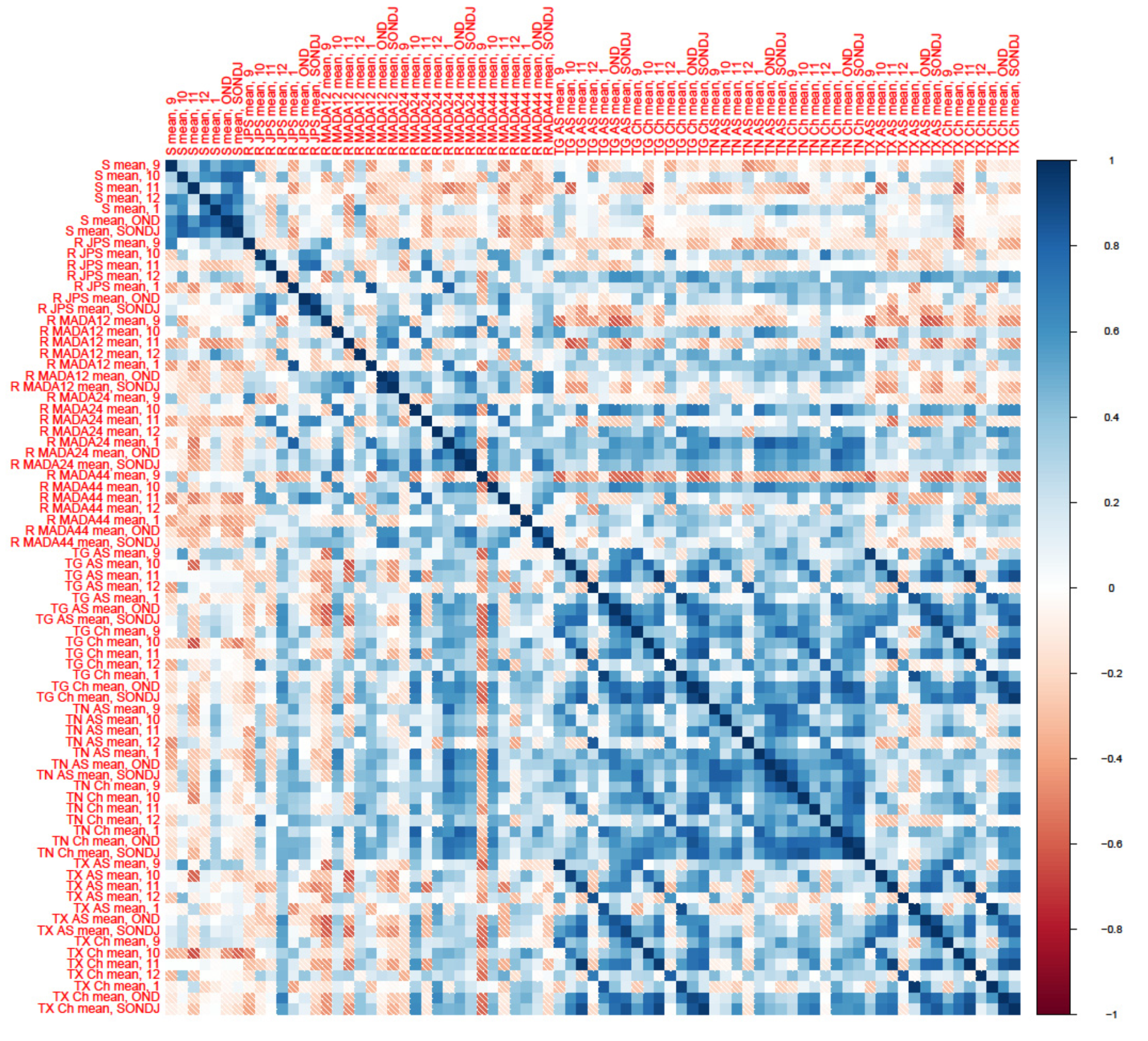
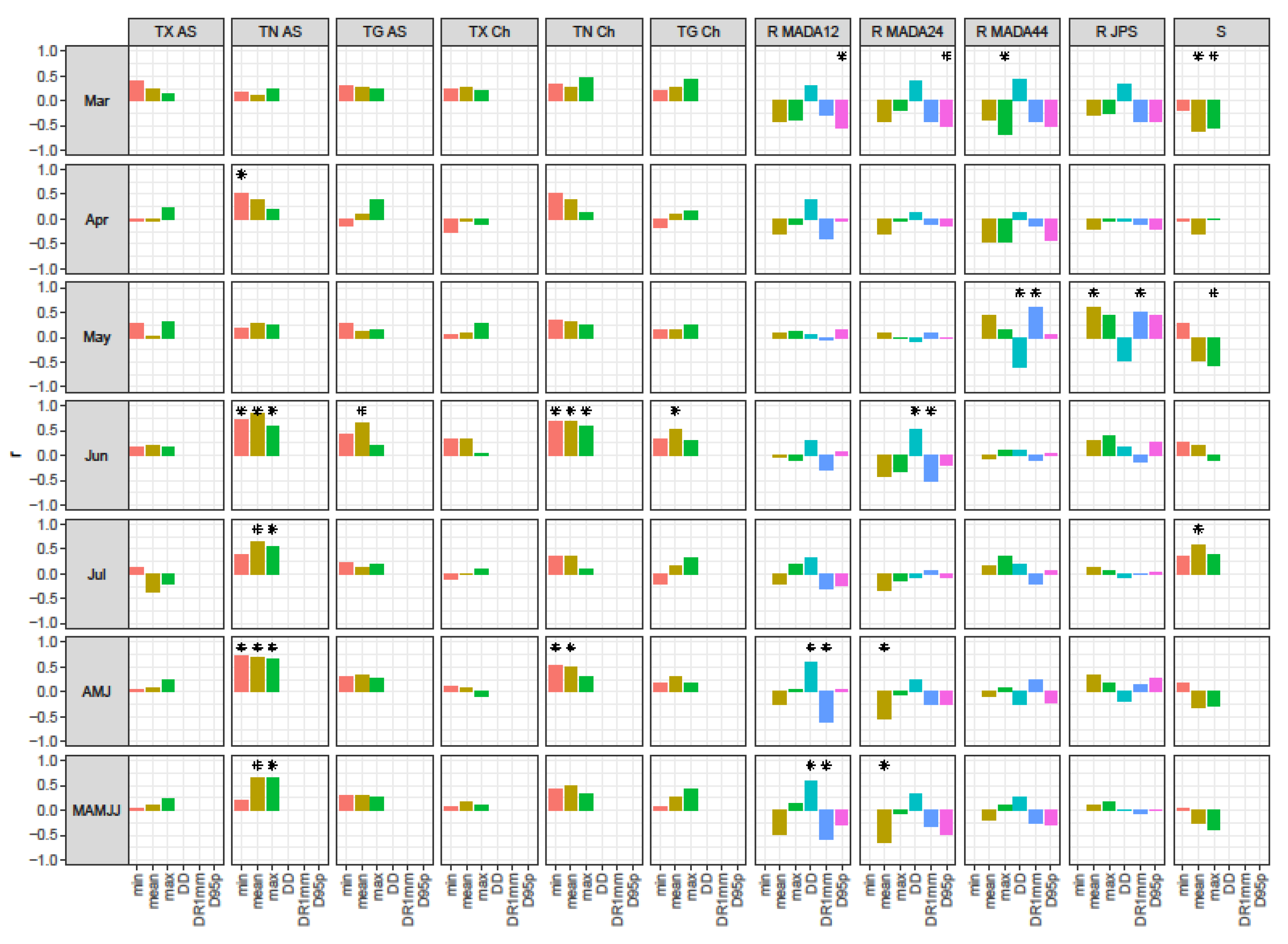
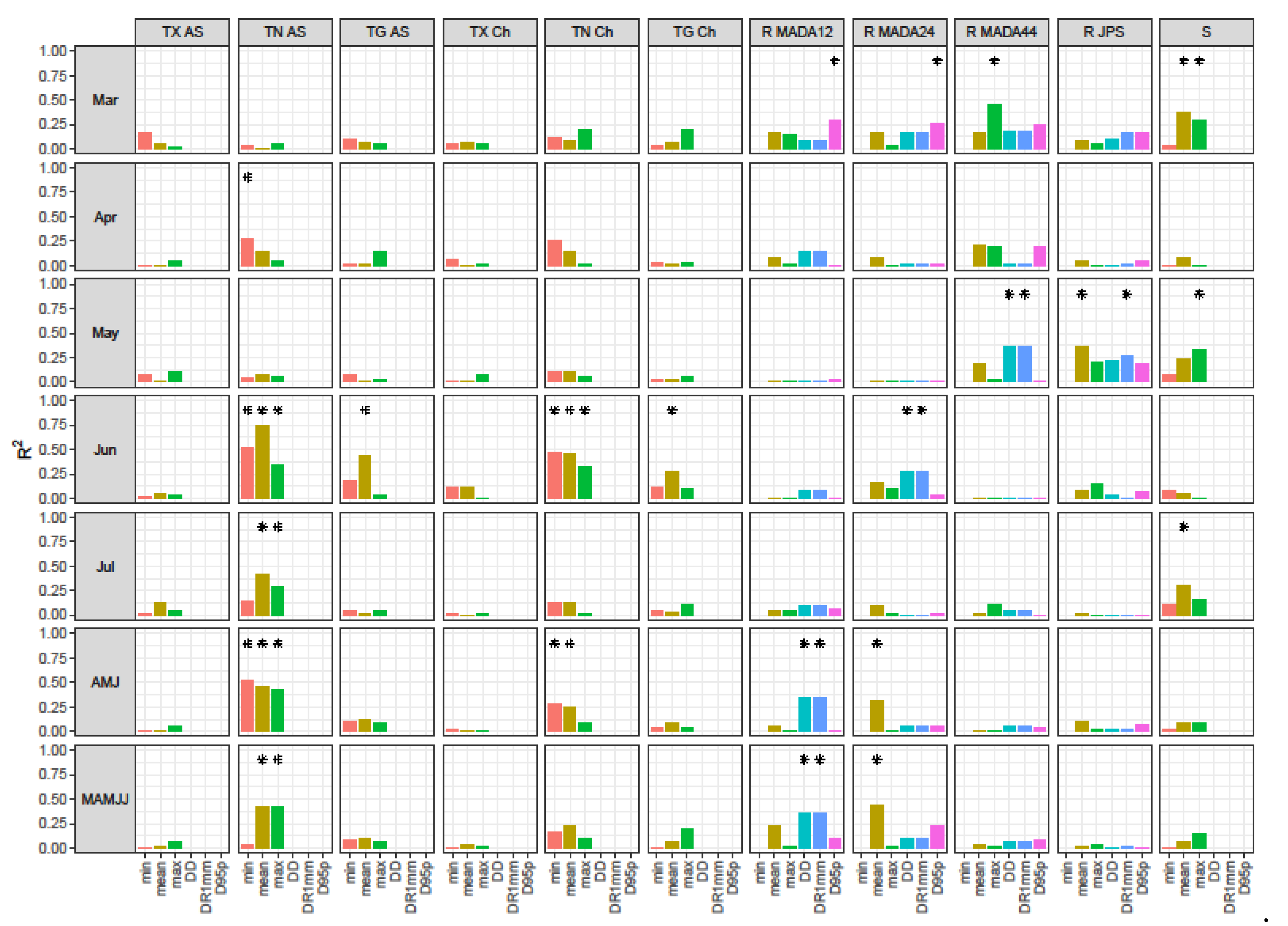
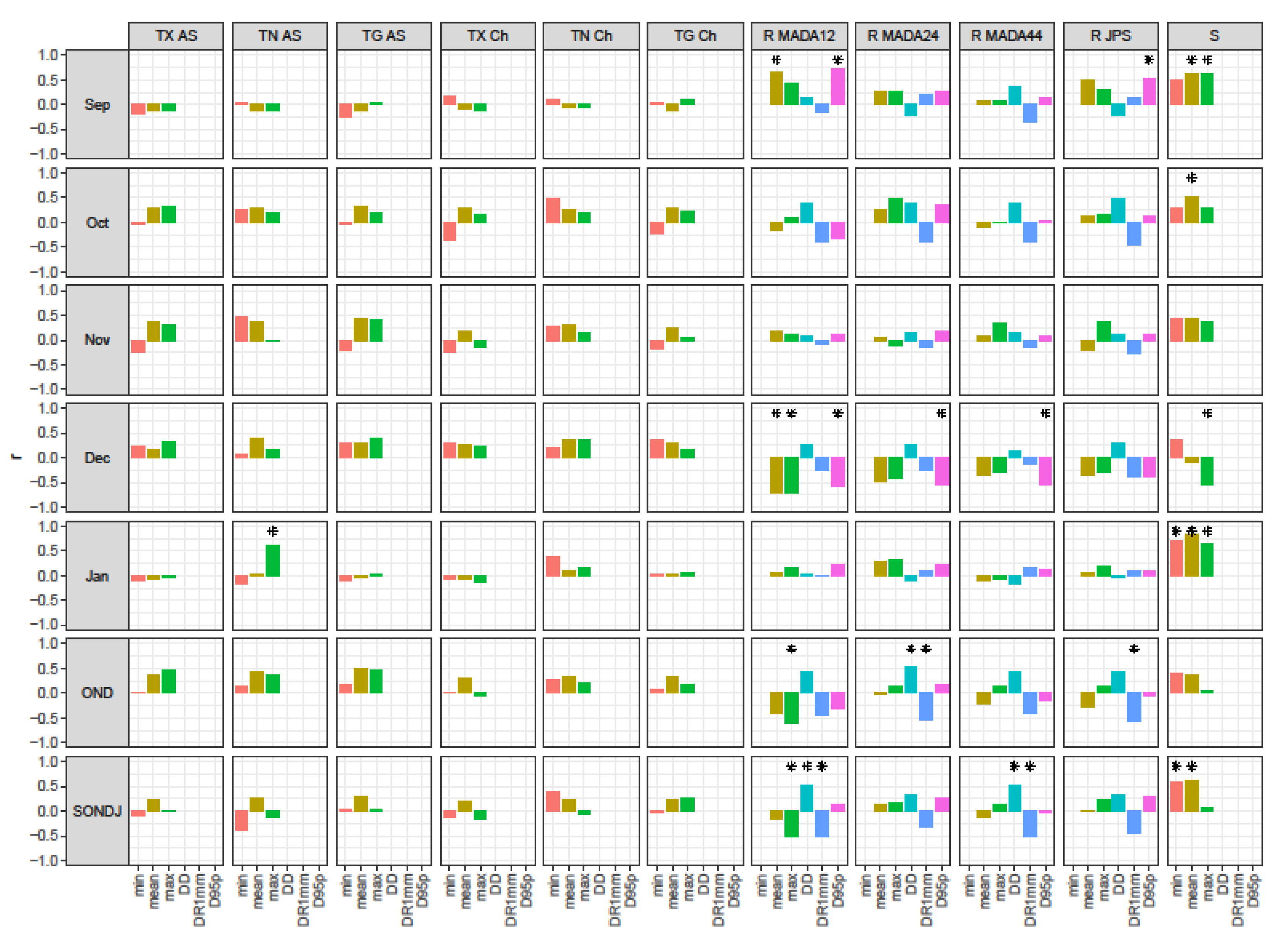

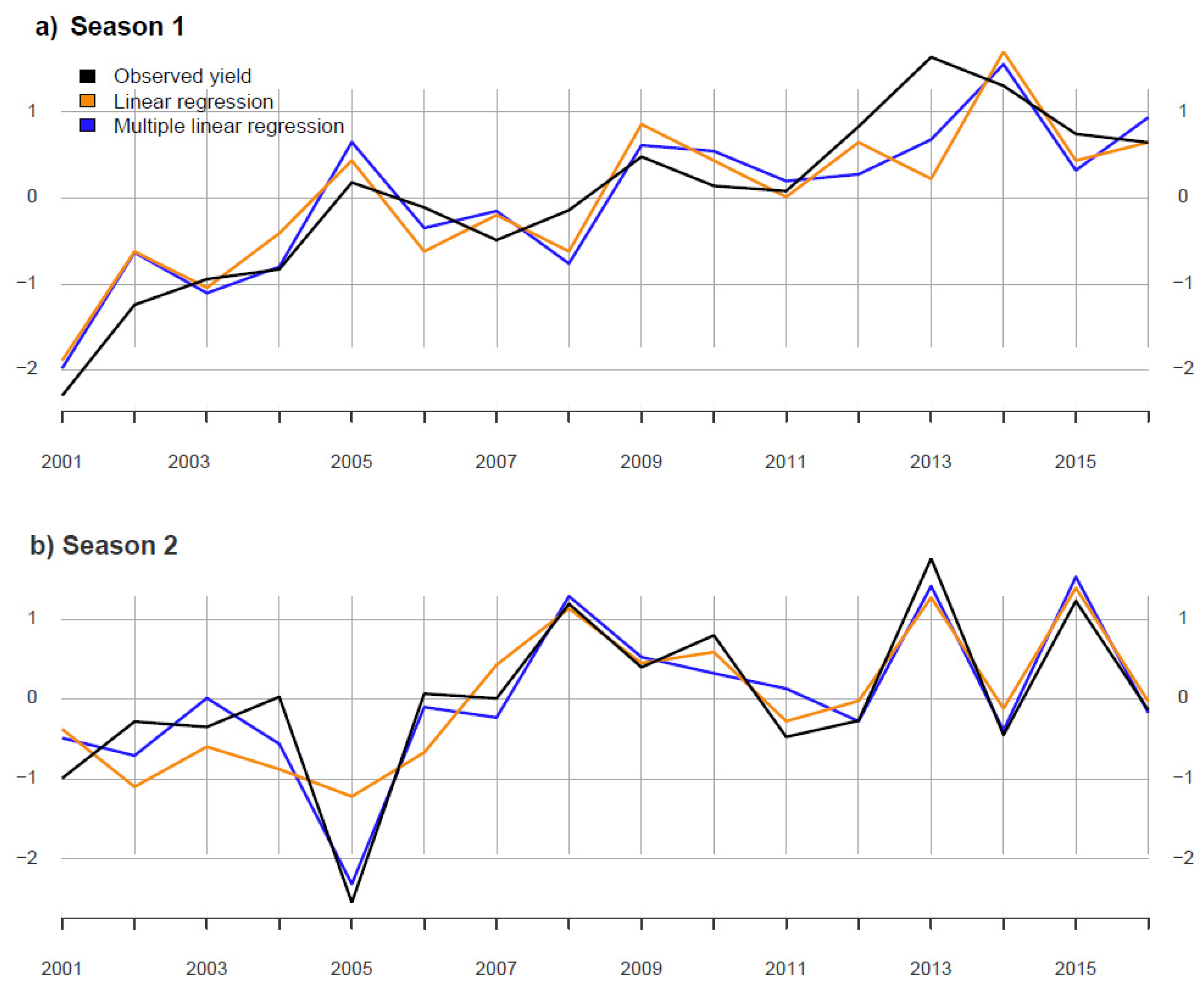
| Season/Growing Phase | Planting | Vegetative (45–55 Days) | Flowering (35 Days) | Maturity (30 Days) | Harvesting |
|---|---|---|---|---|---|
| Season 1 (off-season) | March 1 | March—mid-May | Mid-May—mid-June | June—July | July 31 |
| Season 2 (main season) | September 1 | September—mid-November | Mid-November—mid-December | December—January | January 31 |
| Hydroclimatic Variable | Stations | Index | Unit | Abbreviations Used in This Study | ECTACI Equivalent |
|---|---|---|---|---|---|
| Rainfall | MADA12, MADA 24, MADA 44, JPS | Maximum | mm/d | Rmax | Rx1day |
| Mean | Rmean | - | |||
| Dry days | DD | DD | |||
| Wet days | DR1mm | DR1mm | |||
| Very wet days | D95p | D95p | |||
| Daily maximum temperature | AS, Ch | Maximum | °C | TXmax | TXx |
| Mean | TXmean | GTX | |||
| Minimum | TXmin | TXn | |||
| Daily minimum temperature | AS, Ch | Maximum | °C | TNmax | TNx |
| Mean | TNmean | GTN | |||
| Minimum | TNmin | TNn | |||
| Daily mean temperature | AS, Ch | Maximum | °C | TGmax | XTG |
| Mean | TGmean | GTG | |||
| Minimum | TGmin | NTG | |||
| Daily average streamflow | MADA Kuala Nerang | Maximum | m3/s | Smax | - |
| Mean | Smean | - | |||
| Minimum | Smin | - |
| Statistic | Formula | Explanation |
|---|---|---|
| Pearson Correlation | = The dependent variable data = The mean of dependent variable data = The independent variable data = The mean independent variable data = The fitted value for a specific value of the explanatory variable = The number of observations | |
| Coefficient of Determination | R2==1−= | |
| Adjusted R2 | Radj2= | = The number of explanatory variables in the regression |
| Probability of Detection | TP = True positive i.e., prediction is TRUE when observation is TRUE FN = False negative i.e., prediction is FALSE when observation is TRUE FP = False positive i.e., prediction is TRUE when observation is FALSE | |
| False Alarm Ratio | ||
| Root Mean Square Error |
| Season | Simple Linear Regression | Multiple Linear Regression | |||||||||||
|---|---|---|---|---|---|---|---|---|---|---|---|---|---|
| Equation | R2 | p-Value | POD | FAR | RMSE | Equation | R2 | Adjusted-R2 | p-Value | POD | FAR | RMSE | |
| Season 1(drier) | Yield = 0.86 TNmean_AS(Jun) | 0.74 | <0.01 | 1 | 0 | 0.49 | Yield = + 0.54 TNmean_AS (Jun) + 0.25 TNmin_AS (AMJ) − 0.23 Rmean MADA24 (MAMJJ) | 0.80 | 0.75 | <0.01 | 1 | 0 | 0.43 |
| Season 2(wetter) | Yield = 0.82 Smean (Jan) | 0.67 | <0.01 | 1 | 0 | 0.56 | Yield = + 0.46 Smean (Jan) − 0.40 Rmean MADA12 (Dec) + 0.29 D95p MADA12 (Sep) | 0.87 | 0.84 | <0.01 | 0.75 | 0.33 | 0.34 |
Publisher’s Note: MDPI stays neutral with regard to jurisdictional claims in published maps and institutional affiliations. |
© 2021 by the authors. Licensee MDPI, Basel, Switzerland. This article is an open access article distributed under the terms and conditions of the Creative Commons Attribution (CC BY) license (https://creativecommons.org/licenses/by/4.0/).
Share and Cite
Zulkafli, Z.; Muharam, F.M.; Raffar, N.; Jajarmizadeh, A.; Abdi, M.J.; Rehan, B.M.; Nurulhuda, K. Contrasting Influences of Seasonal and Intra-Seasonal Hydroclimatic Variabilities on the Irrigated Rice Paddies of Northern Peninsular Malaysia for Weather Index Insurance Design. Sustainability 2021, 13, 5207. https://doi.org/10.3390/su13095207
Zulkafli Z, Muharam FM, Raffar N, Jajarmizadeh A, Abdi MJ, Rehan BM, Nurulhuda K. Contrasting Influences of Seasonal and Intra-Seasonal Hydroclimatic Variabilities on the Irrigated Rice Paddies of Northern Peninsular Malaysia for Weather Index Insurance Design. Sustainability. 2021; 13(9):5207. https://doi.org/10.3390/su13095207
Chicago/Turabian StyleZulkafli, Zed, Farrah Melissa Muharam, Nurfarhana Raffar, Amirparsa Jajarmizadeh, Mukhtar Jibril Abdi, Balqis Mohamed Rehan, and Khairudin Nurulhuda. 2021. "Contrasting Influences of Seasonal and Intra-Seasonal Hydroclimatic Variabilities on the Irrigated Rice Paddies of Northern Peninsular Malaysia for Weather Index Insurance Design" Sustainability 13, no. 9: 5207. https://doi.org/10.3390/su13095207
APA StyleZulkafli, Z., Muharam, F. M., Raffar, N., Jajarmizadeh, A., Abdi, M. J., Rehan, B. M., & Nurulhuda, K. (2021). Contrasting Influences of Seasonal and Intra-Seasonal Hydroclimatic Variabilities on the Irrigated Rice Paddies of Northern Peninsular Malaysia for Weather Index Insurance Design. Sustainability, 13(9), 5207. https://doi.org/10.3390/su13095207






